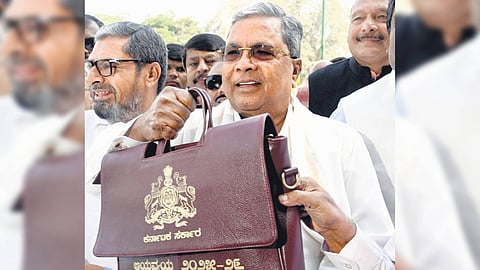

In his 16th budget — his third as chief minister in the current tenure — Siddaramaiah appears to have done a fine balancing act by continuing his government’s thrust on welfare programmes and attempting to cover some lost ground on the infrastructure development front.
Although the budget lacked a wow factor or a big scheme or programme that stood out, it seems that Siddaramaiah and his team endeavoured to cover most aspects of socio-economic development, including a range of schemes for minority welfare. These received flak from the opposition, while the chief minister stood his ground.
The government, which had faced ire over its guarantee-centric approach, acknowledged the role of infrastructure development in driving the state’s economy and job creation while rolling out some schemes to help different sections of society, including farmers.
The proposed rain-fed agriculture policy that the CM mentioned in the budget is likely to indicate the direction in which the government will move to improve agricultural production as 64% or around 64 lakh hectares of the cultivated area in the state is non-irrigated. Even if production rises by one quintal per hectare, it adds significantly to the total production and helps small farmers in a big way.
As per the Karnataka Economic Survey 2024-25, which cited the Agriculture Census 2015-16, the average size of farm holding is 1.36 hectares and 86.81 lakh farm holdings operate on 118.05 lakh hectares. Small and marginal holdings account for 80% of the total holdings and operate 44% of the total operated area.
Efforts to boost agriculture — which is expected to grow at 4 % in 2024-25 as against -4.9 % during 2023-24 — and allied sectors can revitalise the rural economy. The focus on Bengaluru, the engine of the state’s economy, could help retain its formidable position in attracting investments and its potential to increase exports. Karnataka contributes to 20.5% of India’s exports. While merchandise exports are 6.09% of the country’s total exports, software and services exports stand at 41%. There is scope to increase agro-exports which are being explored.
In essence, the budget seems like an effort to put together many manageable initiatives that could accumulate into big gains. But, at the end of the day, the budget merely indicates the government’s intent and its vision for the financial year, and a lot depends on implementation.
A whole-of-government approach is required to effectively implement them, while elected representatives, especially ministers, legislators, and district-level officers, play a pivotal role.
On some projects, the budget announcement could have been clearer. It stated on the Mekedatu Balancing Reservoir across river Cauvery, that the preparatory works had been completed and that the project would be implemented “as soon as the necessary clearances are received from the competent authorities”.
It was a major political issue in the run-up to the 2023 assembly polls. Top Congress leaders took out a padayatra and vowed to implement the project, which, according to them, was crucial for addressing the future drinking water needs of Bengaluru.
However, the project has not made much headway though Deputy Chief Minister and Water Resources Minister DK Shivakumar has taken it up with the Centre on many occasions. Along with its efforts to put pressure on the Centre, the state Congress leaders should try to convince the party’s top leadership to take up the issue with their INDIA bloc ally DMK which is in power in Tamil Nadu.
On another big-ticket project, the Bengaluru tunnel roads, the State Government has stood guarantee to the Bruhat Bengaluru Mahanagara Palike (BBMP) for Rs 19,000 crore to undertake the Rs 40,000 crore project. Long-term measures to ease traffic congestion in the state capital are needed, considering the rapidly rising rate at which vehicles are added every year. However, many experts and members of civil society groups have expressed concerns over the tunnel roads project.
They need to be taken into confidence by holding public consultations and placing all details, including the feasibility reports and scientific studies in the public domain before venturing to take up the mega project.
Be it any infrastructure projects, or welfare schemes announced in the Rs 4.09 lakh crore outlay budget, stakeholders’ participation is crucial.
As Siddaramaiah rightly mentioned at the beginning of his speech, “The budget is not merely a lifeless exercise of adding and subtracting numbers. I stand here with the utmost understanding that I carry a huge responsibility of putting forward our promises made to the seven-crore people of the State, breathing the hopes of a better life.”
It’s time to deliver on those promises.